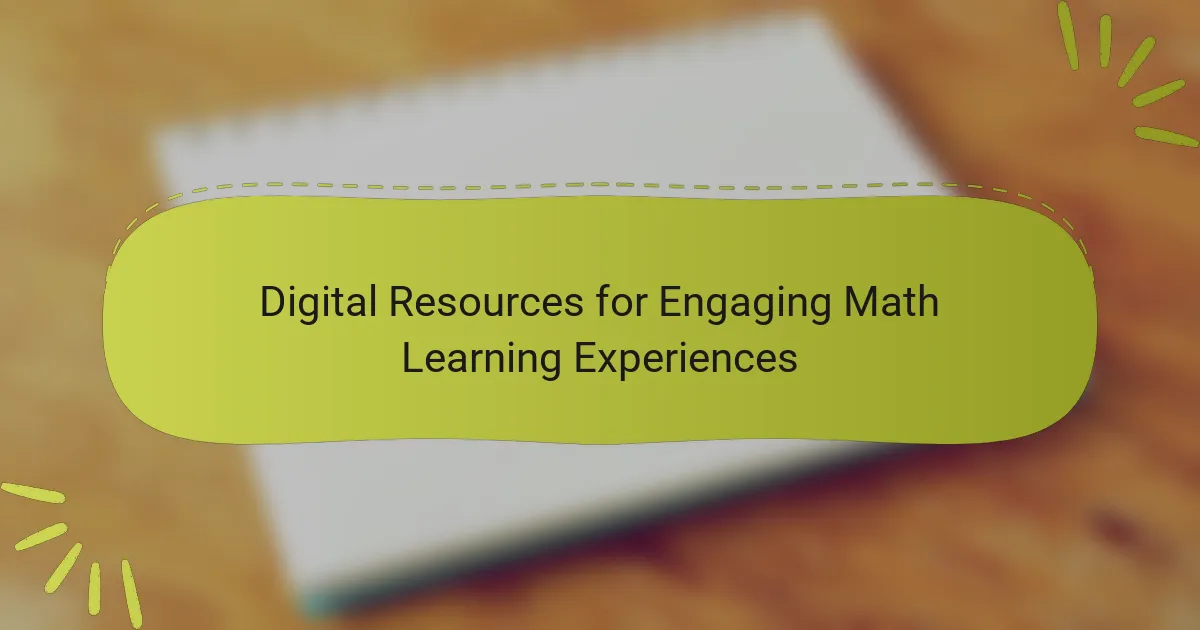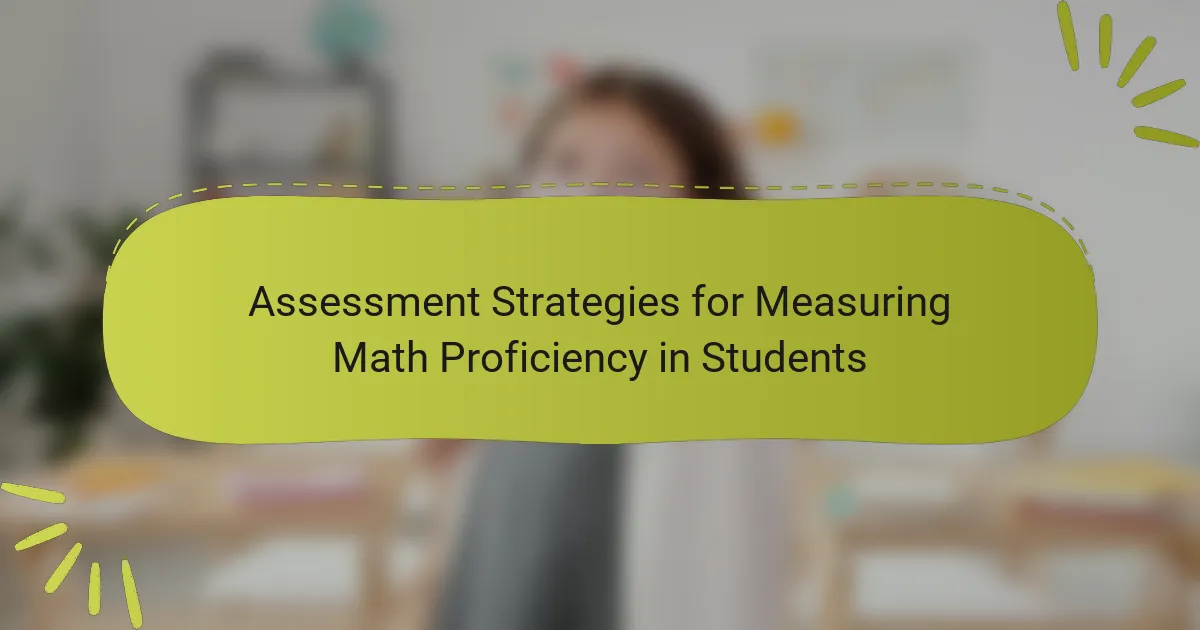Creating inclusive math environments for all learners involves ensuring equitable access to math education by recognizing diverse learning needs and adapting teaching methods. This article outlines strategies for fostering participation among students of varying backgrounds and abilities, emphasizing the importance of differentiated instruction, collaborative learning, and the use of varied instructional strategies. It highlights the positive impact of inclusive practices on student engagement, achievement, social skills, and self-esteem. Additionally, the article addresses the challenges educators face in implementing inclusive practices, including limited resources, lack of training, and classroom dynamics. Ongoing professional development and a culture of respect are essential for successfully creating these inclusive environments.
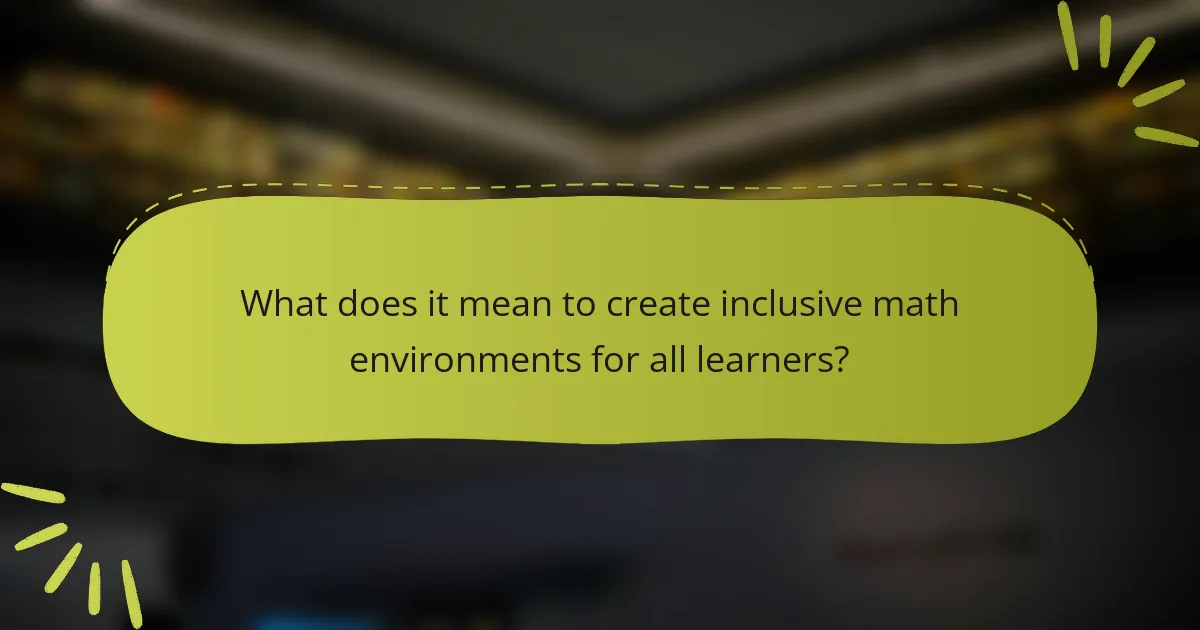
What does it mean to create inclusive math environments for all learners?
Creating inclusive math environments for all learners means ensuring that every student has equitable access to math education. This involves recognizing diverse learning needs and adapting teaching methods accordingly. Inclusive environments promote participation from all students, regardless of their backgrounds or abilities. They utilize varied instructional strategies, such as collaborative learning and differentiated instruction. Research shows that inclusive classrooms enhance student engagement and achievement. Studies indicate that students in inclusive settings develop better social skills and higher self-esteem. Creating such environments requires ongoing professional development for educators. It also involves fostering a culture of respect and support within the classroom.
Why is inclusivity important in math education?
Inclusivity is important in math education because it ensures that all students have equal access to learning opportunities. When math education is inclusive, it accommodates diverse learning styles and backgrounds. This approach fosters a positive learning environment where every student feels valued. Research shows that inclusive classrooms can lead to improved academic outcomes. For example, a study by the National Center for Learning Disabilities found that inclusive practices enhance student engagement and achievement. Furthermore, inclusivity promotes collaboration among students, encouraging them to learn from each other. It also helps to reduce stereotypes and biases related to math abilities. Overall, inclusivity in math education supports the development of critical thinking and problem-solving skills for all learners.
How does inclusivity impact student engagement in math?
Inclusivity significantly enhances student engagement in math. When students feel valued and included, they are more likely to participate actively. Research shows that inclusive practices foster a sense of belonging. This sense of belonging directly correlates with increased motivation to learn. Studies indicate that diverse learning environments promote higher achievement levels. For instance, a 2018 study by the National Center for Education Statistics found that inclusive classrooms improve performance for all students. Engaged students are more likely to collaborate and share ideas. This collaboration leads to deeper understanding and retention of mathematical concepts.
What are the long-term benefits of inclusive math environments?
Inclusive math environments foster collaboration and enhance problem-solving skills. They promote a sense of belonging among students. This leads to increased engagement and motivation in learning math. Research shows that students in inclusive settings tend to perform better academically. A study by the National Council of Teachers of Mathematics found that inclusive practices improve overall student achievement. Additionally, these environments develop social skills and empathy. Students learn to appreciate diverse perspectives and approaches to problem-solving. Long-term, inclusive math environments prepare students for real-world challenges. They equip learners with critical thinking skills essential for future success.
What are the key characteristics of inclusive math environments?
Inclusive math environments are characterized by accessibility, equity, and a supportive community. Accessibility ensures that all students can engage with math content regardless of their learning needs. This includes providing materials in various formats and using technology to assist learning. Equity involves recognizing and addressing the diverse backgrounds and experiences of students. Teachers adapt instruction to meet individual needs and promote participation. A supportive community fosters collaboration among students. This encourages peer learning and builds confidence. Research indicates that inclusive environments improve student engagement and achievement in math.
How do diverse teaching strategies contribute to inclusivity?
Diverse teaching strategies enhance inclusivity by addressing varied learning styles and needs. These strategies include differentiated instruction, collaborative learning, and the use of multiple representations. Differentiated instruction allows educators to tailor lessons to individual student capabilities. Collaborative learning fosters peer interaction, helping students learn from each other. Multiple representations, such as visual aids and hands-on activities, accommodate different cognitive processes. Research indicates that classrooms employing diverse strategies see improved engagement and achievement among all students. For example, a study by Tomlinson (2001) highlights that differentiated instruction leads to higher student motivation and success in diverse classrooms.
What role do classroom resources play in creating an inclusive environment?
Classroom resources play a critical role in creating an inclusive environment. They provide diverse materials that cater to various learning styles and needs. For instance, visual aids can assist visual learners, while manipulatives support kinesthetic learners. Inclusive resources also promote participation from all students, fostering a sense of belonging. Research shows that classrooms with varied resources enhance engagement and achievement among diverse learners. According to a study by Tomlinson et al. (2003), differentiated resources lead to improved outcomes in inclusive settings. This evidence underscores the importance of well-chosen classroom resources in supporting an inclusive educational experience.
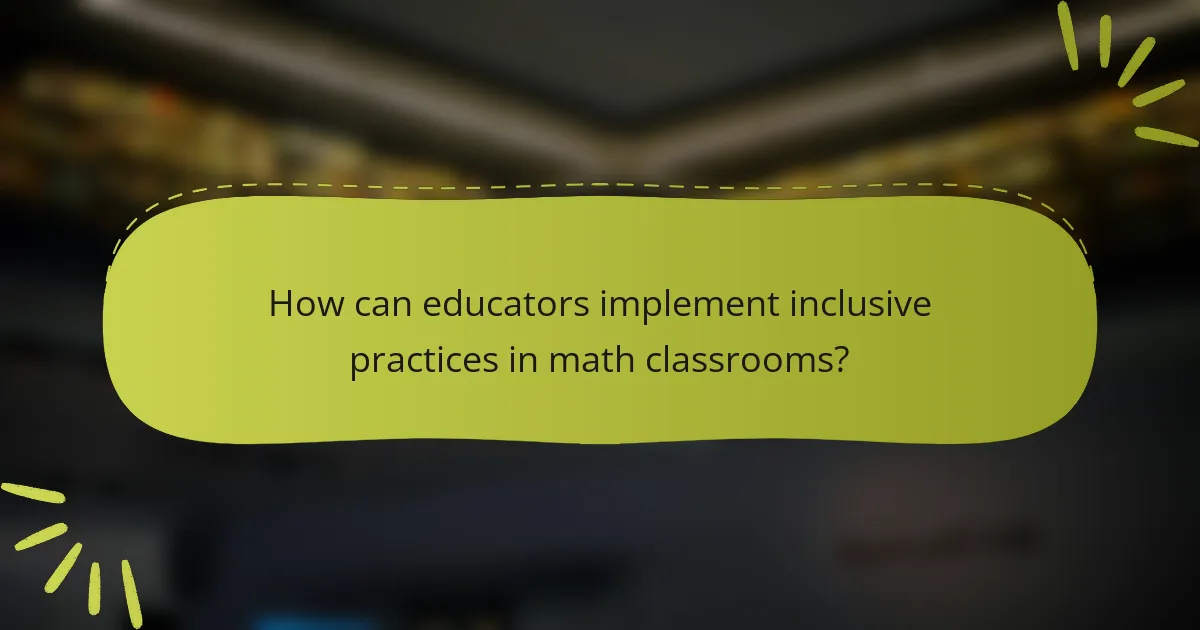
How can educators implement inclusive practices in math classrooms?
Educators can implement inclusive practices in math classrooms by differentiating instruction to meet diverse learning needs. They should use varied teaching methods, such as visual aids, manipulatives, and technology. Collaborative group work encourages peer support and social interaction. Educators must also create a safe environment where all students feel valued. Regular assessment and feedback help identify individual student needs. Professional development can equip educators with strategies for inclusivity. Research shows that inclusive practices improve student engagement and achievement. For instance, a study by the National Center for Learning Disabilities highlights the positive impact of differentiated instruction on diverse learners.
What strategies can be used to accommodate diverse learning needs?
Differentiated instruction is a key strategy to accommodate diverse learning needs. This approach tailors teaching methods to meet individual student requirements. Teachers can use various instructional strategies, such as flexible grouping, to facilitate collaboration among students with different abilities. Incorporating technology, like educational software, can provide personalized learning experiences. Providing multiple forms of assessment allows students to demonstrate understanding in ways that suit them best. Additionally, using visual aids and manipulatives can support various learning styles. Regular feedback helps students track their progress and adjust learning strategies. Professional development for educators enhances their ability to implement these strategies effectively. Research indicates that these methods improve engagement and achievement among diverse learners.
How can differentiated instruction enhance inclusivity in math?
Differentiated instruction enhances inclusivity in math by tailoring teaching methods to meet diverse learner needs. This approach allows educators to address various learning styles, abilities, and interests. For example, teachers can provide varied materials, such as visual aids or hands-on activities, to support different learners. Research shows that differentiated instruction can improve student engagement and achievement. A study by Tomlinson (2001) highlights that students benefit when instruction is aligned with their individual readiness levels. This method fosters a supportive environment where all students feel valued and included. By recognizing and accommodating diverse needs, differentiated instruction promotes equity in math education.
What are effective methods for assessing student understanding in an inclusive way?
Effective methods for assessing student understanding in an inclusive way include formative assessments, differentiated assessments, and peer assessments. Formative assessments involve ongoing feedback during the learning process. This allows teachers to adjust instruction based on student needs. Differentiated assessments cater to diverse learning styles and abilities. They provide various options for students to demonstrate their understanding. Peer assessments encourage collaboration and communication among students. This method fosters a sense of community and shared learning. Research shows that inclusive assessment practices improve overall student performance and engagement. A study by Tomlinson (2001) emphasizes the importance of tailoring assessments to meet individual student needs.
How can collaboration among educators support inclusivity in math education?
Collaboration among educators can significantly enhance inclusivity in math education. By working together, teachers can share diverse strategies that cater to various learning styles. This approach allows for the development of a more comprehensive curriculum. Collaborative planning leads to the integration of multiple perspectives on teaching math. Educators can create a supportive environment that values each student’s unique contributions. Research indicates that collaborative teaching improves student engagement and achievement. A study by Johnson et al. (2019) found that co-teaching models increased participation among underrepresented students. Thus, collaboration fosters a sense of belonging and encourages all learners to succeed in math.
What are the benefits of professional development focused on inclusivity?
Professional development focused on inclusivity enhances workplace culture and employee satisfaction. It fosters diverse perspectives, leading to innovative problem-solving. Inclusive training improves team collaboration and communication. Organizations that prioritize inclusivity see increased employee retention rates. According to a McKinsey report, companies with diverse workforces outperform their peers financially. Inclusivity training equips employees with skills to address biases and promote equity. This development also prepares organizations to better serve diverse customer bases. Ultimately, inclusivity-focused training drives overall organizational success and growth.
How can educators share best practices for inclusive math teaching?
Educators can share best practices for inclusive math teaching through collaboration and professional development. They can form communities of practice to discuss strategies and experiences. Workshops and training sessions can provide structured opportunities for sharing. Online platforms and social media groups can facilitate broader discussions. Educators can also create and share resources such as lesson plans and instructional materials. Research shows that collaboration among educators improves teaching effectiveness. According to a study by the National Council of Teachers of Mathematics, sharing practices leads to better student outcomes. Thus, these methods enhance the overall quality of inclusive math teaching.
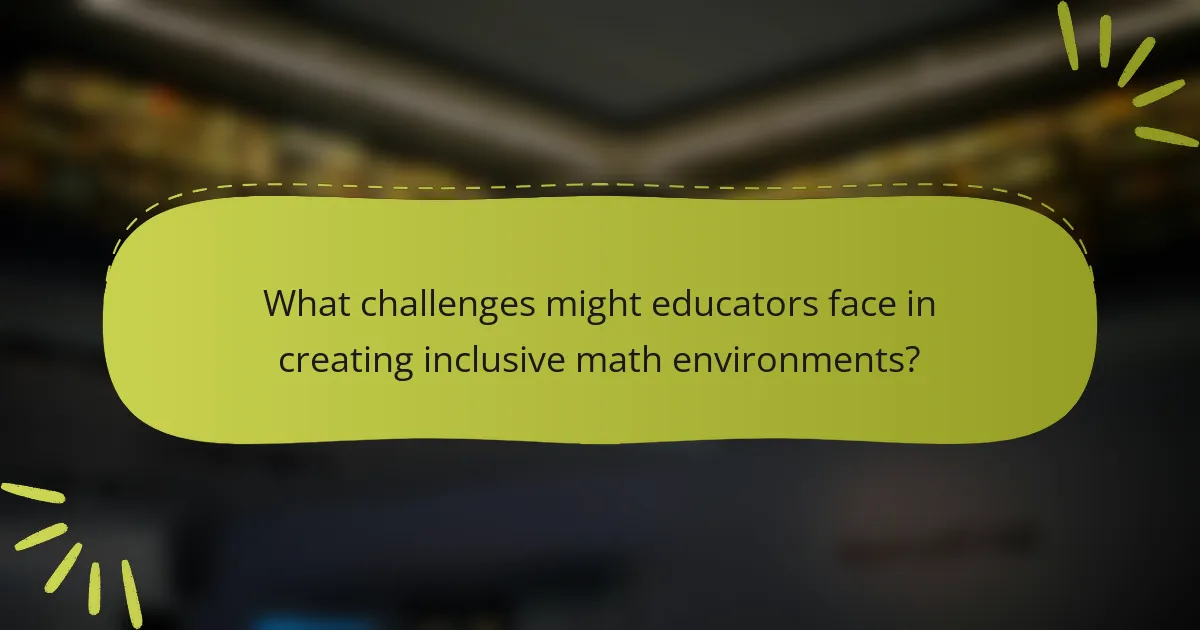
What challenges might educators face in creating inclusive math environments?
Educators face several challenges in creating inclusive math environments. One significant challenge is addressing diverse learning needs. Students have varying abilities and learning styles. This requires differentiated instruction strategies. Limited resources can hinder the implementation of these strategies. Additionally, educators may lack training in inclusive practices. This can lead to ineffective teaching methods. Classroom dynamics can also pose challenges. Some students may dominate discussions, marginalizing others. Lastly, curriculum constraints can restrict the incorporation of inclusive materials. These factors collectively complicate the creation of inclusive math environments.
What common barriers exist in implementing inclusive math practices?
Common barriers in implementing inclusive math practices include lack of teacher training, inadequate resources, and insufficient support systems. Many teachers report feeling unprepared to address diverse learning needs in their classrooms. Research indicates that only 30% of teachers receive training in inclusive education strategies. Additionally, schools often lack materials that cater to various learning styles and abilities. This scarcity can hinder effective instruction. Support from administration is also crucial. Without strong leadership backing inclusive practices, teachers may struggle to implement necessary changes. These barriers collectively impede the development of inclusive math environments.
How can educators overcome resistance to inclusive teaching methods?
Educators can overcome resistance to inclusive teaching methods by providing clear benefits and evidence of success. Research indicates that inclusive teaching improves academic outcomes for all students. Educators should engage in professional development to enhance their skills and confidence in inclusive practices. Collaborative planning with colleagues can foster a supportive environment for implementing these methods. Additionally, involving parents and the community can create a broader support network. Regularly assessing student progress helps demonstrate the effectiveness of inclusive strategies. Sharing success stories from diverse classrooms can also motivate educators to adopt these methods.
What are some misconceptions about inclusivity in math education?
One misconception about inclusivity in math education is that it only benefits underrepresented groups. Inclusivity actually enhances learning for all students. Another misconception is that inclusivity means lowering standards. Research shows that high expectations can coexist with supportive learning environments. Additionally, some believe inclusivity requires separate resources. In reality, effective inclusivity integrates diverse teaching methods into existing curricula. Finally, many think inclusivity is solely about diverse representation. True inclusivity involves creating equitable opportunities for participation and success in math for every learner.
What resources are available to support inclusive math education?
Resources available to support inclusive math education include specialized curriculum materials, teacher training programs, and assistive technology. Curriculum materials designed for inclusivity often provide differentiated instruction strategies. These resources help address diverse learning needs effectively. Teacher training programs focus on equipping educators with skills for inclusive practices. They emphasize understanding various learning styles and disabilities. Assistive technology tools, such as math software and manipulatives, support students with disabilities. Research indicates that inclusive practices enhance student engagement and achievement. The National Council of Teachers of Mathematics provides guidelines for inclusive education. These guidelines serve as a framework for educators to develop inclusive math environments.
How can technology be leveraged to promote inclusivity in math classrooms?
Technology can be leveraged to promote inclusivity in math classrooms by providing adaptive learning tools. These tools can adjust to individual student needs, ensuring that all learners can engage with the material. For instance, software like DreamBox Learning offers personalized learning paths based on student performance. This type of technology helps accommodate diverse learning styles and paces.
Additionally, assistive technologies, such as text-to-speech and speech-to-text applications, can support students with disabilities. These tools enable students to access math content more easily. Research shows that using such technologies can improve engagement and understanding among students with different abilities.
Furthermore, online collaborative platforms allow students to work together regardless of their location. Tools like Google Classroom facilitate group projects and discussions, fostering a sense of community. This collaboration can enhance peer learning and support among students.
Overall, integrating technology in math classrooms creates a more inclusive environment by addressing varying needs and promoting collaboration.
What community resources can educators tap into for support?
Educators can tap into various community resources for support. Local educational organizations often provide professional development workshops. Libraries offer access to educational materials and tutoring programs. Community centers may host after-school programs that align with math curriculum. Nonprofits focused on education can provide mentorship and tutoring services. Parent-teacher associations often facilitate community engagement and resources. Local universities might offer partnerships for research and student volunteers. These resources enhance educators’ capacity to create inclusive math environments.
What practical tips can educators use to foster inclusivity in math environments?
Educators can foster inclusivity in math environments by implementing diverse teaching strategies. They should incorporate multiple representations of mathematical concepts. This includes visual aids, manipulatives, and real-world applications. Group work can promote collaboration among students with varying abilities. Assigning roles within groups can ensure participation from all members. Providing flexible assessment options can accommodate different learning styles. Offering additional support through tutoring or resources is also beneficial. Creating a positive classroom culture encourages risk-taking and valuing diverse perspectives. These strategies have been shown to enhance engagement and understanding in mathematics for all learners.
Creating inclusive math environments for all learners focuses on ensuring equitable access to math education for students with diverse learning needs. The article outlines the importance of inclusivity in math education, highlighting its impact on student engagement, collaboration, and long-term academic success. Key characteristics of inclusive environments, such as accessibility and varied teaching strategies, are discussed, along with practical tips for educators to implement inclusive practices effectively. The article also addresses challenges and misconceptions surrounding inclusivity while providing resources and methods for leveraging technology to enhance learning experiences in math classrooms.


